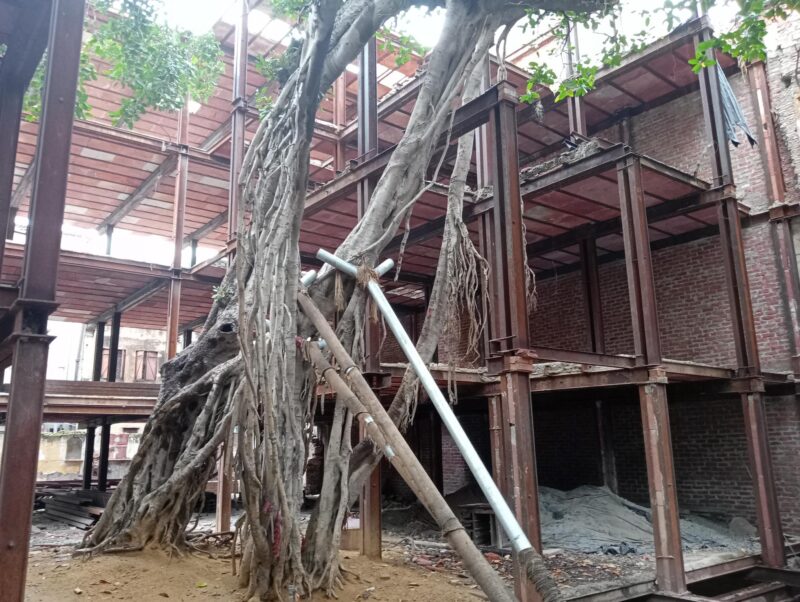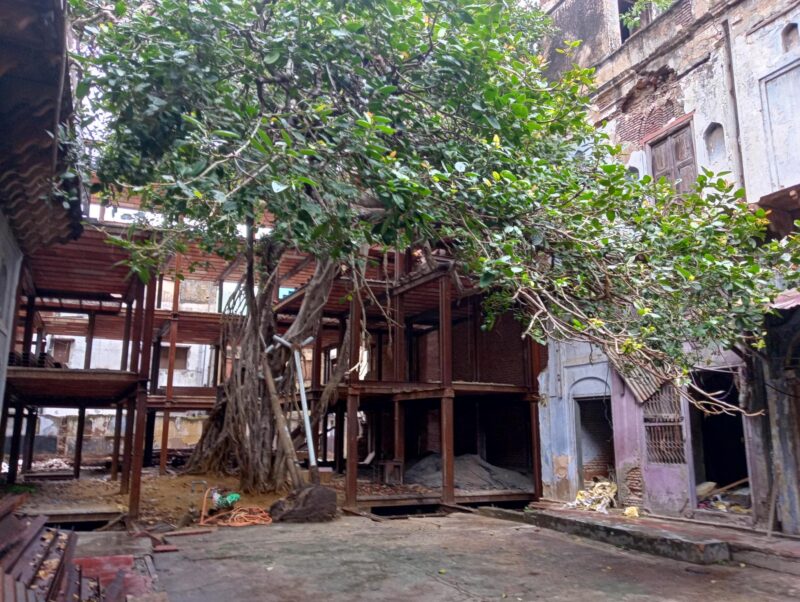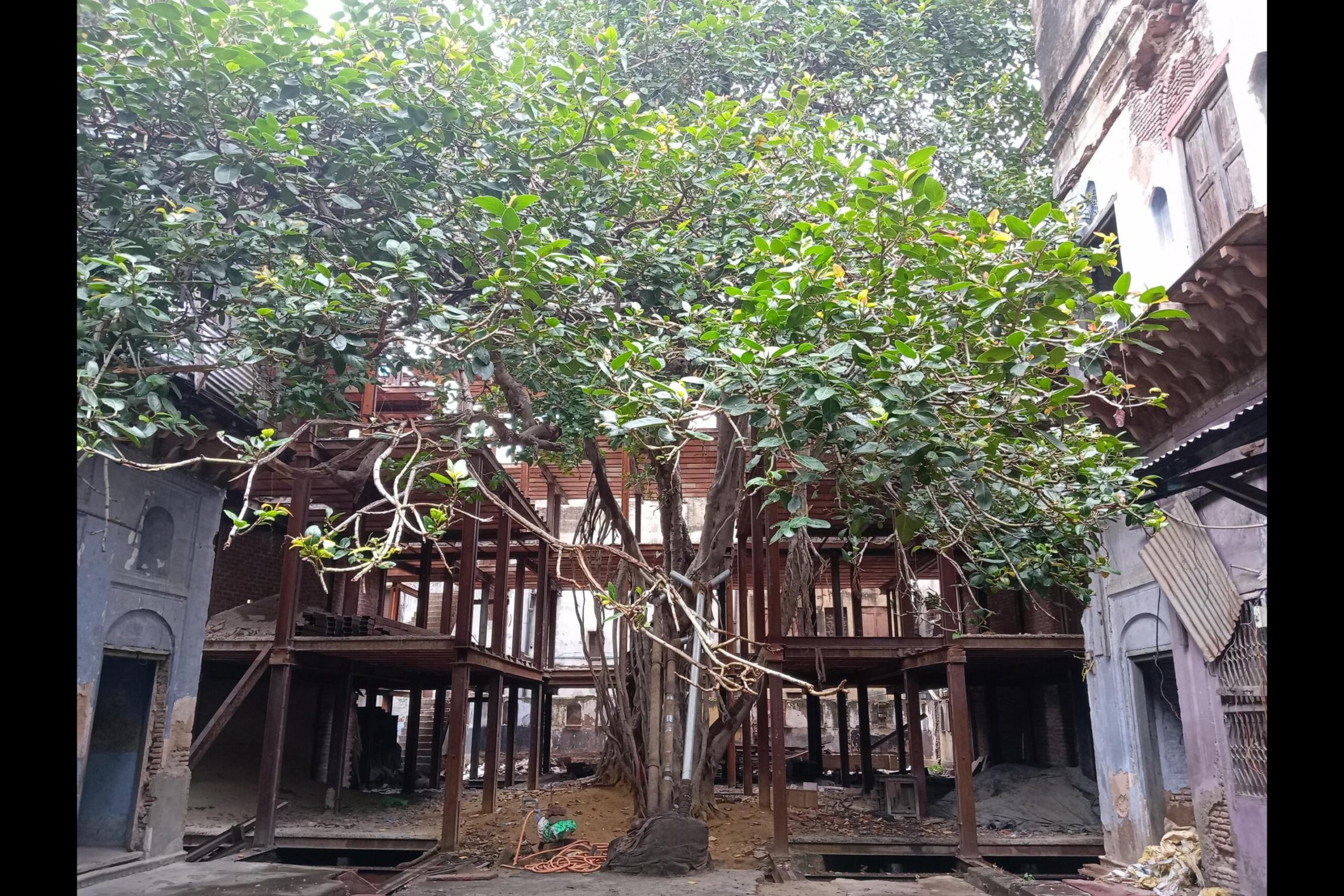For the past three centuries, a living entity has quietly watched history unfold in Delhi – from the capital falling to the British to India’s independence and 75 years of the country’s freedom. A mute and patient spectator firmly rooted in one of narrow alleys in Chandni Chowk. The entity is a 300-year-old banyan tree.
However, with quick progress of capitalism, its wrath has brought in threats of grave damage to the tree. The over 300-year-old banyan tree’s invaluable heritage stands at the threat of a builder’s axe.
To protect it with all his resources, Kushmakar Rastogi took up a legal battle with the construction company building a five-storey unauthorised complex, which weakened the foundation of the banyan tree, over ten years ago and has since been embroiled in court procedure.
Since Bahadur Shah Zafar
During the reign of the last Mughal emperor, Bahadur Shah Zafar, it is believed that the tree was planted by Satyanarayan Gurhwali, who was known to be the richest man in the area. According to local tales, there are many stories around the centuries-old tree – fares, children playing around its grand old trunk, saints meditating, etc.
“There used to be fares all the time around this tree and people from far off places use to come to visit. Such was the charm! These stories have been passed down to us from generations,” says Rastogi.
Rastogi challenged the constructions around the tree soon after they began started building a multi-storey back in 2011. “Someone has to do something about it. How can they destroy such a significant part of our heritage,” he asks.
Once known for its glory, the Banyan tree today is hidden behind a line of busy shops replete with salwar suits, wedding gowns and Delhi’s favourite chhole kulche and samosa-jalebi.

As one enters the Nai Sarak in Chandni Chowk, close to the iconic Jama Masjid, in the middle of its loud hustle-bustle, an existence of a 300-year-old tree is almost unfathomable. It’s only after enquiring at least a dozen people does one find the narrow lane, clothed with garments, which leads to the tree.
The century’s old mansion that encircles the tree is in fact known as ‘Kothi Barwali’ (house around the banyan tree). Not a soul lives in the Kothi today.
“Here, my father spent most of life and we lived our formative years. This place used to be the hub of frolic and holy affairs at the same time. Hindu saints used to come here to meditate and visitors from across the country arrived to take their blessings. This tree saw the British come and go,” Rastogi says.
Roots chopped off
Pointing towards the tree, Rastogi shows two thick iron pipe-like structures anchored to the ground that are support it from crashing down. “Upon the Delhi High Court’s order, construction around the tree was stopped and it further instructed the NDMC (North Delhi Municipal Corportion) to ensure that no further damage is caused to tree. So, these structures were brought in to create a support system,” he says.

However, a significant “irreparable” damage has already been caused to it. “Besides, the construction is firstly illegal because one cannot build a basement within the walled city (Chandni Chowk-Chawr Bazar area). The court had ordered to stop the construction immediately in 2014. But construction work properly stopped during the first lockdown in 2020. So, a lot of damage was done by then,” the 44-year-old says.
Concrete walls were built around the giant roots of the tree, which weakened its foundation and as a result, it slowly began to slant and it didn’t grow to its full potential. “They constructed the basement in the way that its roots are unable to spread further,” he says.
The construction was started by Shree Ram Group under Ashok Agarwal, who passed away recently.
In its order, Justice Najmi Waziri had mentioned, “The said roots have been chopped-off mid-air and they are unable to find a support in the soil because of the unauthorised construction.”
Rastogi’s plea in the Delhi HC also seeks permission to “take care” of the tree. “We wanted to adopt the tree, but it is not feasible as there is a slew of conditions imposed by the Forest Department. Otherwise, we really want to take care of it. It’s like a grandparent, under whose shade we all grew up,” Rastogi says.
Rastogi, who runs his garment shop that was first established by his grandfather in 1938, continues, “The Forest Department’ condition is such that everything will be their undertaking, however, all responsibility will be ours. Now, these builders have massive syndicate, who will single-handedly take on them? But in all these years, Forest officials have only visited the place once. I have myself visited their head office to submit my complaint, but nothing happened about it. No further action to protect it.”

“Our fight is to save the tree. Aap ped ko chhodke kuch bhi bana lijiye (You can construct anything without harming the tree),” the petitioner says.
The matter will again be heard on 17 October this year.
A breathing space
“Today, Chandni Chowk is a concrete jungle. All you can see is buildings – old and new. This tree is the only source of oxygen for us. There are very few trees here and none are over centuries-old. So, imagine rest of all the trees have been cut down. Already there is so much pollution,” Rastogi says.
Even during peak days of pollution, the petitioner says that the banyan tree used to give a lot of relief. Since, its spread has diminished, its potential has reduced.
A banyan tree can live for up to 500 years however, if it can be properly taken care of it can live longer. “No one actually knows a lifespan of a banyan tree. The one in Kolkata’s Botanical Garden is close to 300 years and it sprawls for over 3km. So, imagine what would have been the potential of this tree,” tree conservationist Asit Mukherjee says.
“We are not just bearing the fruits of what our ancestors have done for nature, but also destroying them. No one is planting a tree, but everyone is chopping one,” he adds.
Throwing light on its benefits, Mukherjee says, “A Banyan tree is a gaint source of oxygen and its fruits attracts birds. A handful of trees like the Peepal and Banyan give out so much oxygen in 24 hours. All parts of Banyan – fruits, leaves, roots and bark – are used in ethnomedicine. Besides, it’s famous for is its aerial roots, which sprout from branches and eventually reach the soil. The tree also has a unique relationship with a wasp that has coevolved with it and is the only insect that can pollinate it.”
“If you have seen a banyan leaf, you would notice its size. Its large leaves absorb more of the sun’s heat and its thickness is better heat exchange. This way it also gives relief from heat and keeps the air cooler. Moreover, its roots have qualities to hold the soil together,” Mukherjee says.
Terming the tree’s present condition “horrific”, Justice Waziri had said, “How can you do this to a 300-year-old tree? It has existed even before the Britishers could even think of coming to India. It is a part of the heritage of this city. How can you damage it in this manner?”





